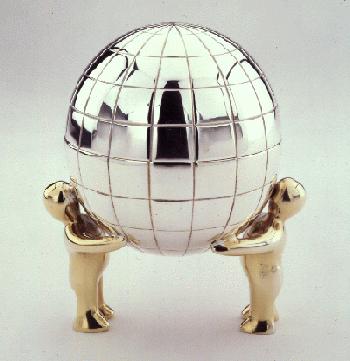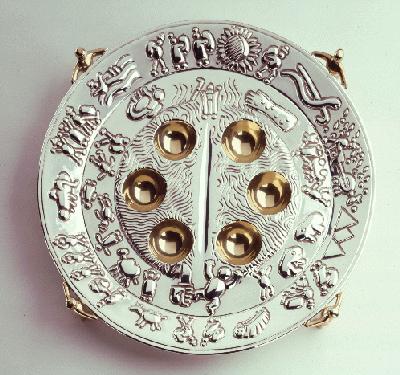|
|
 |
Tom Otterness, American (Wichita, KS), 1952-? Tom Otterness is a sculptor who casts his work in bronze, giving it the look and feel of monuments. He underines this sense of importance, however, by creating subjects which at first glance seem too cute to be so serious, an indication of a certain kind of whimsy.
Tom Otterness is represented by Brooke Alexander Gallery. His work has been exhibited at the MoMA, NY; The Corcoran Gallery of Art, Washington D.C.; and the Sapporo Art Park, Tokyo. It is included in the permanent collections of MoMA, NY; The Brooklyn Museum, Dallas Museum of Art, San Francisco Museum of Modern Art, The Guggenheim Museum, and The Lannan Foundation, CA.
|
 |

Despite the fact that Otterness uses cute subjects to portray his scenes, there is indeed a serious message. For 42nd Street, he has made a huge, up-ended penny with small figures riding on top drinking champagne. They seem unaware that two workers below are pushing the penny along like a giant wheel. But before they topple, the penny will have rolled over another character, unfortunately in its path. The playfulness of the representation belies its symbolism: that those at the top, given indifference to those who labor on their behalf, may destroy themselves. 
Description of Elijah Cup:
Tom Otterness has created an edition entitled "Elijah Cup". The sterling silver goblet, when covered, symbolizes the earth and is held up by two 24 karat gold vermeil figures. "Elijah Cup" can be used during the Passover Seder either alone or in conjunction with the artist's "Seder Plate". It can also be used as a non-religious object to commemorate a wedding, anniversary or other ceremonial occasion and functions as a traditional cup on any table. |

Description of Seder Plate:
"Seder Plate" provides a new and innovative approach by a contemporary sculptor to the traditional story of the Exodus from Egypt. The compartments for the ritual food are set into a symbolic Red Sea, with Moses parting it. The remaining images, drawn from the Passover Hagaddah include the ten plagues, Aaron's staff turned into a serpent, the Paschal lamb and the four sons, who support and elevate the plate. Description of THE TABLES, 1986-87
Cor-ten steel and bronze, 138 x 458, 114 (overall)
Whitney Museum of American Art, New York.
The follies and absurdities that plague all civilizations are the subject of Tom Otterness' ambitious sculptural installation, The Tables. this work, three Cor-ten steel picnic tables are home to more than one hundred cast-bronze Lilliputian people, fantastic animals, and odious monsters, all absorbed in a topsy-turvy world of dramatic social encounters and class struggle. The toylike cuteness and comic humor of these inhabitants fade quickly as the grim realities of life in our post-industrial society are revealed.
One table represents nature: peaceful creatures till the earth in a seemingly bucolic, pastoral setting. At the other end of the installation, factory workers toil and others forge at their furnaces in a tableau signifying the world of industry. The center table, urban reality, signals the convergence of nature and industry. While all the tiny figures naively go about their daily chores, the planet racked mass hangs ready to drop, the explosion of a whale like bomb appears imminent, and an immense spider stands ready to forage and destroy all in her path.
Visitors are encouraged to sit at these tables and survey Otterness imaginary world.
Layered references to popular culture, literature, cinema, Walt Disney, and comic strips abound in the artist's unique apocalyptic vision.  |
|  |
|
 |
|



